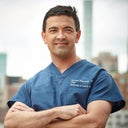Any CO2 resurfacing, dermabrasion, or chemical peel will tighten the skin, improve on it's laxity, improve on wrinkles (up to 30-50% per treatment). No resurfacing technique is good for lifting as sagginess of the tissues is a problem of the underlying structures and not the skin, with resurfacing you are only targeting the skin. Gravity will always win over skin tightening (jowls, neck). You can't confuse tightening of the skin with lifting of the tissues; those are 2 very different terms.In my opinion, ActivFX does shrink skin up to some limit. That is the main reason when someone has transconjusctival eyelid surgery to remove fat; a chemical peel or ActiveFX (CO2 resurfacing) can be used to remove and tighten the skin (shrink it) without surgical excision. This is great for young patients because it prevents an incision under their eyelids. Most (if not all) surgeons do a chemical peel or laser after transconjunctaval fat excision to shrink the skin. On older patients then a skin pinch excision might be better, but it leaves a scar.Also patients that are young that have wrinkles under their eyelids can benefit from fractional resurfacing to reduce the amount of wrinkles. They will still have wrinkles in the lower eyelids especially when they smile because more skin is driven upward by the smiling movement. There is no way to get wrinkle free, but it can be diminished. You also have to be careful with the amount of resurfacing and aggressiveness of the treatment. The more aggressive you are in this area to remove wrinkles and tighten, it can backfire with an ectropion or eversion of the lower eyelid as you removed too much skin.Wrinkles is a normal part of aging, what we want is to be realistic and diminish them, not try to remove them or erase them.Usually any type of resurfacing (laser, dermabrasion, chemical) needs 6 mo to a year to allow the dermis to have the fibroblast lay down the collagen that they are going to be produced in order to decrease the amount of wrinkles in the area. This is the unpredictable part of the procedure (neither the surgeon nor the patient have control) and where the variance occurs. Different patients heal in different ways and not everybody lays down the same amount of collagen fibers.You also mentioned that your friend did the procedure due to a slight amount of laxity. Some difference could be seen if proper before and after pictures are taken under the same conditions. This means to have pictures with the same camera, same light, same background. I have a Vectra system that also helps take that same picture and position of the patient every time and it is amazing how much you can tell about a procedure with that system.Thermage and Ultherapy work in a different way. One uses radiofrequency and the other focused ultrasound. They try to do changes to the tissues under the skin. This means that the skin will remain with the problems that it has as it will be untouched. Many of this therapies are still rudimental and have the problem of not delivering constant results in the great majority of patients. Combination therapy can be done, but then cost of multiple procedures could be an issue for just a "slight amount of laxity"."This answer has been solicited without seeing this patient and cannot be held as true medical advice, used against any physician or as medical witness expert advise or court, but only opinion. This answer is for educational purposes and should not be relied upon as a substitute for medical advice you may receive from your physician. Seek in-person treatment with a trained medical professional for appropriate care."Hope this helps,Dr. Gus Diaz



